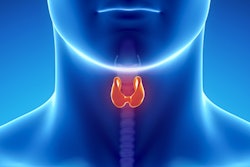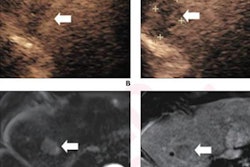
Contrast-enhanced ultrasound (CEUS) is more accurate than color Doppler in characterizing different types of soft-tissue vascular abnormalities, according to research published May 23 in the European Journal of Radiology.
A team led by Dr. Ankit Sangwan from the All India Institute of Medical Sciences in New Delhi also found that CEUS also increased the degree of diagnostic confidence and is safe for patients, which could reduce the need for CT or MRI scans.
"The various vascular anomalies were found to have distinctive temporal and morphological subjective enhancement patterns," which can be helpful in characterizing them, Sangwan and colleagues wrote.
Vascular anomalies encompass many diseases with varying characteristics, and this can be challenging for clinicians to treat in children and adolescents. Not having enough information about these anomalies can lead to misdiagnosis.
Patient history, clinical examination, and Doppler ultrasound can diagnose particular anomaly types, but MRI may be needed for a more confident diagnosis. The study authors wrote that compared with ultrasound, MRI is costly, time-consuming, and may require general anesthesia in children.
Contrast-enhanced ultrasound has been explored in recent years for assessing tissue perfusion via intravascular microbubble contrast agents. The researchers have touted its ability to evaluate flow dynamics in lesions without any ionizing radiation or risk of contrast-induced nephropathy. CEUS can also be performed in the same session as a Doppler-ultrasound examination.
In the current study, Sangwan et al wanted to find out the role of CEUS in characterizing suspected soft-tissue vascular abnormalities and compare its diagnostic accuracy with Doppler-ultrasound.
They looked at data from a total of 221 patients, 93 in a pilot group and 128 in a validation group. They found that adding CEUS increased the diagnostic accuracy of Doppler-ultrasound from 76.5% to 88.2%. The researchers wrote that by correctly diagnosing more cases, MRI was avoided.
They also found that venous malformations were the most common entity found on CEUS in 77 cases, followed by fibroadipose vascular anomaly in 46 cases.
The researchers also looked at 32 cases of vascular tumors. Out of these, pyogenic granuloma/lobular capillary hemangioma was the most common type found (16) followed by noninvoluting congenital hemangioma (10).
The study authors wrote that the main advantage of CEUS is that it can be combined with Doppler ultrasound in the same session, meaning it can accurately characterize abnormalities without using radiation or sedation in small children.
"No sedation or anesthesia was required for children as young as two years of age for CEUS," they added. "It was done in five to 10 minutes in the presence of the parent or guardian to alleviate anxiety and improve cooperation, in the same sitting as Doppler-ultrasound evaluation."
They also noted that CEUS showed "good correlation" with Doppler-ultrasound in arteriovenous malformations and vascular tumors. It also showed "clear advantage" in evaluating low-flow malformations compared to Doppler-ultrasound.




















